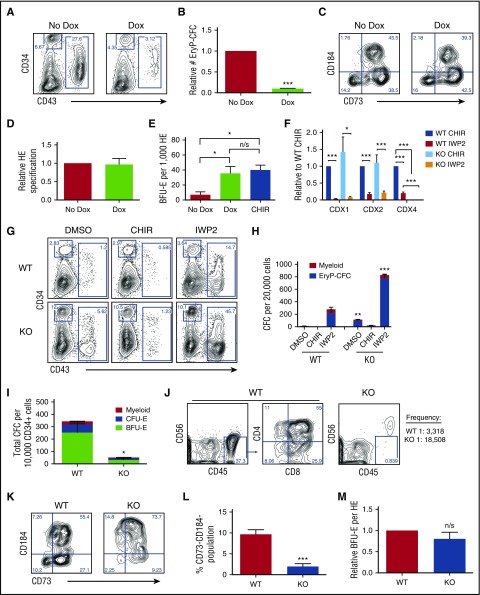Figure 2.
Mesodermal CDX4 expression is critical for efficient definitive hemogenic endothelial specification. (A-E) Analyses of primitive and definitive hematopoietic potential following doxycycline-inducible CDX4 expression via the AAVS1 locus. (A) Representative flow cytometric analysis of CD34 and CD43 expression on day 9 of differentiation, following IWP2 and doxycycline treatment from days 2 to 3 of differentiation. (B) Normalized EryP-CFC potential at day 9 of differentiation as in panel A. n = 3 mean ± SEM. Student t test: ***P < .001. (C) Representative flow cytometric analysis of CD73 and CD184 expression within CD34+CD43− cells obtained on day 8 of differentiation, following DMSO treatment, with or without doxycycline, from days 2 to 3 as in Figure 1A. (D) Quantification of CD73−CD184− HE as in panel C. n = 4. Student t test: P > .05. (E) Quantification of definitive erythroid burst forming unit (BFU-E) potential from 1000 CD34+CD43−CD73−CD184− hemogenic endothelial progenitors, following 9 days of hemato-endothelial culture to promote the endothelial-to-hematopoietic transition. n = 3 mean ± SEM. Student t test compared with DMSO: *P < .05. (F-M) Analyses of primitive and definitive hematopoietic potential from CDX4−/Y hPSCs. (F) qRT-PCR analysis of CDX1, CDX2, and CDX4 expression on day 3 of differentiation within wild-type (WT) and CDX4−/Y (knockout [KO]) hPSCs, following CHIR99021 or IWP2 treatment as in Figure 1A. n = 4 mean ± SEM. Student t test: *P < .05; ***P < .001. (G) Representative CD34 and CD43 flow cytometric analyses on day 9 of differentiation following WNT manipulation from days 2 to 3 as in Figure 1A. (H) Primitive hematopoietic potential within day 9 differentiation cultures of WT and CDX4−/Y (KO) hPSCs, following WNT manipulation as in Figure 1A. n ≥ 4 mean ± SEM. Student t test compared across WT and KO, per condition: **P < .01; ***P < .001. (I) Quantification of definitive erythro-myeloid colony-forming potential from CHIR99021-derived CD34+ progenitors, following 9 days of hemato-endothelial culture to promote the endothelial-to-hematopoietic transition. Cultures were treated with CHIR99021 from days 2 to 3 as in Figure 1A. Normalized to 10 000 CD34+CD43− day 8 input cells. n ≥5 mean ± SEM. Student t test: *P < .05. (J) Representative flow cytometric analysis of T-lymphoid potential of WT and CDX4−/Y (KO) hPSCs, under limiting dilution conditions. Shown is T-lymphoid analyses following 28 days OP9−DL4 coculture under T-lymphopoiesis promoting conditions. Input population shown is 10 000 CD34+ progenitors. Limiting dilution analyses indicate WT CD34+ cells possess lymphoid progenitors at a 1:3318 frequency, and KO cells at 1:18 508 frequency. n = 3. P = .00224. (K) Representative flow cytometric analysis of CD73 and CD184 expression within CD34+CD43− cells obtained on day 8 of differentiation, following CHIR99021 treatment from days 2 to 3 as in Figure 1A. (L) Quantification of CD73−CD184− HE as in (K). n > 6. Student t test: ***P < .001. (M) Normalized definitive BFU-E potential from CD34+CD43−CD73−CD184− hemogenic endothelial progenitors, following 9 days of hemato-endothelial culture to promote the endothelial-to-hematopoietic transition. n = 5 mean ± SEM. Student t test: P > .05. CFU-E, erythroid colony-forming unit; DOX, doxycycline; n/s, not significant.

